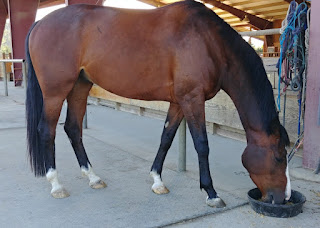We really enjoy having Connie and Dexter with us at the Farm, and appreciate her expertise as a registered nurse—she will be co-leading a first aid class in our upcoming "All About the Prep: Safety and Readiness for Rider and Horse" camp. This is a very timely and interesting article which adds another useful tool to our equine health toolkit! -MG
Author’s note:
The Wise Horseman at Freedom Farm monthly blog posts well-researched, timely tips and tricks for the care and training of our horses. How many read and practice the wisdom sent to us for free...? Well, I do. Allow me to add my story to the thread of articles here on grass laminitis prevention [select ‘laminitis’ from among the tags at right to call up the articles - ed.] -
I have a dream. My dream is to have my horse Dexter out in a pasture, frolicking with friends and living a horse’s full life. However...vig·i·lance/ˈvijələns/noun
 |
| Connie and Dexter |
So what’s this about checking pulses? Let me digress:












